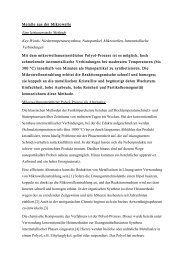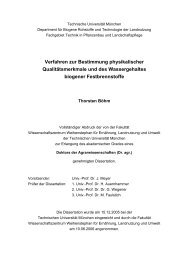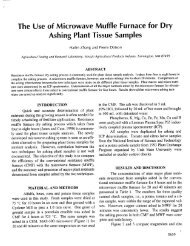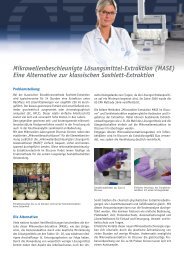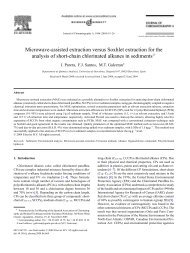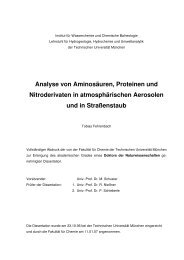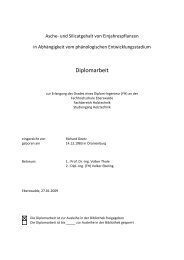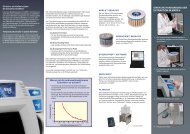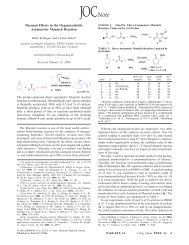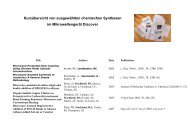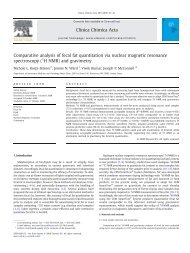Continuous Size Tuning of Monodisperse Zno ... - CEM Gmbh
Continuous Size Tuning of Monodisperse Zno ... - CEM Gmbh
Continuous Size Tuning of Monodisperse Zno ... - CEM Gmbh
You also want an ePaper? Increase the reach of your titles
YUMPU automatically turns print PDFs into web optimized ePapers that Google loves.
DOI: 10.1002/adma.200801433<br />
<strong>Continuous</strong> <strong>Size</strong> <strong>Tuning</strong> <strong>of</strong> <strong>Monodisperse</strong> ZnO Colloidal<br />
Nanocrystal Clusters by a Microwave-Polyol Process and<br />
Their Application for Humidity Sensing**<br />
By Xianluo Hu,* Jingming Gong, Lizhi Zhang, and Jimmy C. Yu*<br />
Over the past decade, formation <strong>of</strong> monodisperse colloidal<br />
nanocrystals with size and shape control has been intensively<br />
pursued. This topic is <strong>of</strong> key importance for elucidating unique<br />
size/shape-dependent physiochemical properties and for<br />
applications in optoelectronics, sensing, catalysis, crystallization,<br />
and mineralization. [1–4] Currently, a major research<br />
direction appears to be shifting to create size and shapeselective<br />
secondary structures <strong>of</strong> colloidal nanocrystals either<br />
by self-assembly or through direct solution growth. This<br />
research trend has been evidenced by a number <strong>of</strong> interesting<br />
pioneer works published during the past several years. [5–7]<br />
As expected, manipulation <strong>of</strong> secondary structures <strong>of</strong> colloidal<br />
nanocrystals leads to fine-tuned interactions between nanocrystal<br />
subunits, and eventually enhanced collective properties<br />
and functionalities <strong>of</strong> nanocrystal ensembles. [7] In expanding<br />
fundamental exploration in this area, nevertheless, there are<br />
still concerns and challenges to chemists and materials<br />
scientists in developing efficient and cost-effective synthetic<br />
methodologies for creating secondary structures <strong>of</strong> colloidal<br />
nanocrystals. In particular, scale-up production <strong>of</strong> high-quality<br />
colloidal nanocrystals from uniform nucleation and nanocrystal<br />
growth will become critical to the realization <strong>of</strong> advanced<br />
nanodevices and many high-end nanotechnological applications.<br />
Conventional heating for producing colloidal nanocrystals,<br />
however, <strong>of</strong>ten relies on thermal conduction <strong>of</strong> black-body<br />
radiation to drive chemical reactions. The reaction vessel<br />
usually serves as an intermediary for energy transfer from the<br />
heating source to the solvent and finally to reactant molecules.<br />
There are inevitable disadvantages, especially at relatively low<br />
temperatures, such as sharp thermal gradients throughout the<br />
[*] Dr. X. L. Hu, Pr<strong>of</strong>. J. M. Gong, Pr<strong>of</strong>. L. Z. Zhang<br />
Key Laboratory <strong>of</strong> Pesticide & Chemical Biology <strong>of</strong> Ministry <strong>of</strong><br />
Education<br />
College <strong>of</strong> Chemistry<br />
Central China Normal University<br />
Wuhan 430079 (P. R. China)<br />
E-mail: xlhu07@gmail.com<br />
Pr<strong>of</strong>. J. C. Yu, Dr. X. L. Hu<br />
Department <strong>of</strong> Chemistry<br />
The Chinese University <strong>of</strong> Hong Kong<br />
Shatin, New Territories, Hong Kong (P. R. China)<br />
E-mail: jimyu@cuhk.edu.hk<br />
[**] The authors acknowledge the support from a Strategic Investments<br />
Scheme administrated by The Chinese University <strong>of</strong> Hong Kong and<br />
the National Science Foundation <strong>of</strong> China (grant nos. 20777026 and<br />
20503009). Supporting Information is available online from Wiley<br />
InterScience or from the authors.<br />
bulk solution, slow reaction kinetics, and nonuniform reaction<br />
conditions. [8] In regard to chemical scale-up, it is worth noting<br />
that inhomogeneous effects and thermal gradients would be<br />
magnified severely during nanocrystal growth. As a result, this<br />
may incur unwanted poor nucleation and/or broadened size<br />
distributions. Therefore, developing new synthetic strategies to<br />
overcome the above mentioned problems is highly desirable.<br />
Microwave dielectric heating can address the issue <strong>of</strong><br />
heating inhomogeneity and slow reaction kinetics. This<br />
technique is becoming an increasingly popular method <strong>of</strong><br />
heating samples for nanomaterial synthesis. Fundamentally,<br />
microwaves heat reacting species differently than conventional<br />
means. Microwave irradiation is a clean, cheap, and convenient<br />
method <strong>of</strong> heating that <strong>of</strong>ten achieves higher yields and<br />
shorter reaction times. [8–10] Microwave irradiation is also<br />
unique in providing scaled-up processes without suffering from<br />
thermal gradient effects, thus opening up new avenues for<br />
potentially large-scale industrial production <strong>of</strong> high-quality<br />
nanomaterials. [11–13] More importantly, modern microwave<br />
systems possess the capabilities <strong>of</strong> time and temperature<br />
programming, allowing fast and easy optimization <strong>of</strong> experimental<br />
factors. [14] This is very beneficial for creating numerous<br />
synthetic recipes, preparing high-quality nanomaterials, and<br />
scaling up production. Recently, we have developed a<br />
microwave-enhanced hydrothermal approach for producing<br />
colloidal a-Fe2O3 in closed aqueous systems. [15] By controlling<br />
the reactant concentrations, we were able to achieve uniformsized<br />
a-Fe 2O 3 nanocrystals with continuous aspect-ratio tuning<br />
and fine shape control. In this communication, a new microwavepolyol<br />
way to size-tunable ZnO nanocrystal clusters will be<br />
described.<br />
Zinc oxide is a wide bandgap (3.37 eV) semiconductor with<br />
large exciton binding energy (60 meV). There have been many<br />
synthetic approaches reported for preparing well-defined ZnO<br />
nanostructures with diverse morphologies. [16–22] Owing to the<br />
intrinsic nature <strong>of</strong> polar hexagonal-phase ZnO with an a:c axial<br />
ratio <strong>of</strong> 1:1.6, however, most <strong>of</strong> these reported methods<br />
produce 1D or branched nanostructures. The fabrication <strong>of</strong><br />
complex ZnO colloids with secondary microstructures is<br />
difficult because <strong>of</strong> the lack <strong>of</strong> appropriate and generalized<br />
synthetic methodologies. [21] A high-temperature nonhydrolytic<br />
sol-gel route based on the ester-elimination reaction<br />
between zinc acetate and alcohol has been proposed for<br />
growing uniform hierarchically self-assembled ZnO spheres<br />
composed <strong>of</strong> anisotropic cone-like nanocrystals as well as<br />
Adv. Mater. 2008, 20, 4845–4850 ß 2008 WILEY-VCH Verlag GmbH & Co. KGaA, Weinheim 4845<br />
COMMUNICATION
COMMUNICATION<br />
soluble ZnO nanocrystals with tetrapod and<br />
spiked-cluster morphologies. [22a,b] Zeng and<br />
Liu fabricated three-tiered organization <strong>of</strong><br />
ZnO nanobuilding blocks into hollow spherical<br />
conformations by a template-assisted<br />
method. [22c] More recently, aggregation <strong>of</strong><br />
ZnO nanocrystallites involving secondary<br />
structures has been proven to be an effective<br />
way to generate light scattering within the<br />
photoelectrode film <strong>of</strong> dye-sensitized solar<br />
cells (DSSCs) while retaining the desired<br />
specific surface area for dye-molecule<br />
adsorption. [22d] Despite these advances, the<br />
assembly <strong>of</strong> ZnO colloidal nanocrystals in a<br />
facile manner into advanced secondary<br />
structures with continuous size tuning still<br />
remains a significant challenge.<br />
Taking ZnO as an example, here we<br />
present a rapid and economical route based<br />
on an efficient microwave-polyol process to<br />
synthesize uniformly sized ZnO colloidal<br />
nanocrystal clusters (CNCs) in an open polyol system.<br />
Microwave irradiation promotes Zn(II) acetate to be hydrolyzed<br />
in diethylene glycol (DEG, a polyhydric alcohol with a<br />
boiling point <strong>of</strong> 244–245 8C) in a short time. DEG was selected<br />
as the polar solvent because <strong>of</strong> its high permittivity (e ¼ 32),<br />
enabling its high dissolving capacity for highly polar inorganic<br />
and a variety <strong>of</strong> organic compounds. [23] An additional advantage<br />
is that the high polarizability <strong>of</strong> DEG makes it an excellent<br />
microwave absorbing agent, thus leading to a high heating rate<br />
and a significantly shortened reaction time. [9] Encouragingly,<br />
this work provides the flexibility for fine tuning ZnO CNCs<br />
with precise size-control ranging from about 57 to 274 nm<br />
through an efficient and cost-effective approach that may be<br />
adopted for industrial production. To the best <strong>of</strong> our knowledge,<br />
this is the first report on the microwave-polyol synthesis<br />
<strong>of</strong> monodisperse size-tailored ZnO CNCs. The as-formed ZnO<br />
CNCs not only provide flexible building blocks for potential<br />
3D photonic crystals, but are ideal candidates for systematically<br />
studying their nanoarchitecture-dependent performance<br />
in optical, catalytic, and sensing applications. In this<br />
work, the resulting size-tunable ZnO CNCs are used as<br />
resistor-type humidity sensors. They show quick response/<br />
recovery and high sensitivity at room temperature.<br />
Scheme 1 illustrates the formation process <strong>of</strong> ZnO CNCs.<br />
Microwave heating at 180 8C promotes the hydrolysis <strong>of</strong><br />
Zn(OAc)2 in DEG to form zinc glycolates or alkoxide derivatives.<br />
Then, the Zn-complexes transform into ZnO nanocrystals<br />
through dehydration under microwave irradiation.<br />
This route belongs to the general chemie douce method and is<br />
closely related to the sol-gel process. By optimizing the<br />
experimental conditions, these fresh-formed ZnO nanocrystals<br />
spontaneously aggregate to form raspberry-like 3D clusters.<br />
Representative field-emission scanning electron microscopy<br />
(FESEM) and transmission electron microscopy (TEM)<br />
images <strong>of</strong> the products are shown in Figure 1. Clearly, the<br />
Scheme 1. Schematic representation <strong>of</strong> ZnO cluster formation. For clarity, the charges for the<br />
complexes are omitted.<br />
aggregates are spherical in shape and have rough surfaces. The<br />
ZnO CNCs have very narrow diameter distributions with a<br />
standard deviation <strong>of</strong> less than 5%. Close observation confirms<br />
that these monodisperse colloidal particles consist <strong>of</strong> small<br />
primary particles. We could easily tune the size <strong>of</strong> the ZnO<br />
CNCs from about 57 to 274 nm by simply decreasing the<br />
amount <strong>of</strong> Zn-complex precursors while keeping all other<br />
parameters constant. Such size tunability may arise from slight<br />
differences in the amount <strong>of</strong> H 2O and crystal nuclei induced by<br />
varying additions <strong>of</strong> Zn-complex solution. Both higher H 2O<br />
content and higher Zn-complex concentration could accelerate<br />
the hydrolysis <strong>of</strong> Zn(OAc)2 and dehydration <strong>of</strong> the newly<br />
formed Zn-complexes, thus leading to more nuclei in the bulk<br />
solution and finally smaller oxide clusters. The growth <strong>of</strong> ZnO<br />
CNCs may follow the well-documented two-stage growth<br />
model, [24] whereby the primary ZnO nanocrystals ( 8 nm) first<br />
nucleate in a supersaturated solution and then aggregate into<br />
larger raspberry-like assemblies ( 57–274 nm in diameter).<br />
The crystalline structure <strong>of</strong> the products was characterized by<br />
X-ray diffraction (XRD). Figure 1h displays a typical XRD <strong>of</strong><br />
the product with an average cluster diameter <strong>of</strong> 274 nm. This<br />
pattern can be indexed to a pure phase <strong>of</strong> wurtzite-type<br />
hexagonal ZnO (space group P6 3mc (186), JCPDS 79-2205,<br />
a ¼ 3.2501 A ˚ , c ¼ 5.2071 A ˚ ).<br />
High-magnification TEM and high-resolution TEM<br />
(HRTEM) images provide further insight into the structural<br />
information on the secondary structure <strong>of</strong> the ZnO CNCs.<br />
Figure 2a shows a typical bright-field TEM image at a high<br />
magnification for an individual cluster <strong>of</strong> 86 nm in diameter.<br />
Clearly, small primary nanocrystals with sizes <strong>of</strong> 6–10 nm<br />
are present in this cluster. Its corresponding electron<br />
diffraction (ED) pattern is shown in Figure 2b, suggesting<br />
the single-crystal-like nature <strong>of</strong> ZnO CNCs. Lattice fringes<br />
were recorded for a small cluster with a diameter <strong>of</strong> 57 nm.<br />
The HRTEM image (Fig. 2c) further supports the claim <strong>of</strong><br />
4846 www.advmat.de ß 2008 WILEY-VCH Verlag GmbH & Co. KGaA, Weinheim Adv. Mater. 2008, 20, 4845–4850
Figure 1. Representative FESEM and TEM images <strong>of</strong> ZnO CNCs. The average diameters <strong>of</strong> the<br />
CNCs, calculated by measuring more than 100 clusters for each sample, are 57 (a), 86 (b), 125 (c),<br />
162 (d),183 (e), 210 (f), and 274 nm (g). The scale bars are 1 mm for FESEM images and 100 nm<br />
for TEM images. h) Typical XRD pattern <strong>of</strong> the 274 nm ZnO CNCs. The XRD line pattern<br />
corresponds to bulk hexagonal wurtzite ZnO (bottom).<br />
analogous single crystallinity. As shown in Figure 2d, a<br />
representative intensity pr<strong>of</strong>ile covers the line scan (labeled by<br />
a line in Fig. 2c) across the lattice fringes. The periodic fringe<br />
spacing <strong>of</strong> 2.8 A ˚ corresponds to interplanar spacing between<br />
the {100} planes <strong>of</strong> the wurtzite ZnO. Very interestingly, all<br />
<strong>of</strong> the primary nanocrystals crystallographically align with<br />
adjacent ones in the same crystal orientation. The singlecrystal-like<br />
structure is also mirrored in the fast Fourier<br />
transform (FFT) pattern (inset <strong>of</strong> Fig. 2c). Nevertheless, the<br />
diffraction spots (Fig. 2b) that are slightly widened into ellipses<br />
indicate small misalignments among the primary nanocrystals.<br />
The local elemental composition <strong>of</strong> the formed clusters was<br />
confirmed by energy dispersive X-ray (EDX) microanalysis at<br />
the single-cluster level (Fig. 2e). It confirms the presence <strong>of</strong><br />
Zn and O.<br />
Microwave irradiation plays a crucial role in the formation<br />
<strong>of</strong> ZnO CNCs with a single-crystal-like feature based on<br />
rapid non-equilibrium kinetics. As schematically depicted in<br />
Scheme 1, small primary ZnO nuclei are generated by the rapid<br />
microwave-induced hydrolysis <strong>of</strong> Zn 2þ and dehydration <strong>of</strong><br />
resulting Zn-complexes in DEG at 180 8C. Meanwhile, the<br />
freshly formed nanocrystals are unstable due to their high<br />
surface energy, and thus they have a great<br />
tendency to aggregate rapidly. This aggregation<br />
process leads to final monodispersed<br />
CNCs in which the primary nanocrystals<br />
assemble through the same crystallographic<br />
orientation. Such a formation process <strong>of</strong><br />
ZnO CNCs may be explained by the wellknown<br />
growth mechanism <strong>of</strong> ‘‘oriented<br />
attachment’’. [5a,6b] Besides owing to the<br />
excellent microwave-absorbing characteristic<br />
<strong>of</strong> polar ZnO, ‘‘hot surfaces’’ on solid<br />
ZnO may be created under microwave<br />
irradiation, speeding up the nanocrystal<br />
growth and subsequent assembly into clusters.<br />
In an alternating electromagnetic field,<br />
the high conductivity and polarization <strong>of</strong> the<br />
DEG solvent and ZnO can induce localized<br />
ionic currents on the ‘‘hot surface’’ <strong>of</strong> ZnO,<br />
providing additional driving force for mass<br />
transport and directional crystallographic<br />
fusion <strong>of</strong> nanocrystals. An added benefit <strong>of</strong><br />
the microwave field is that it can directly heat<br />
the newly formed ZnO nuclei and nanocrystals.<br />
This creates a condition where the<br />
ZnO crystals are at a substantially higher<br />
temperature than the rest <strong>of</strong> the bulk<br />
mixture. Such superheating effects cannot<br />
be achieved by conventional means.<br />
The study <strong>of</strong> luminescence properties can<br />
shed some light on defects in the ZnO<br />
nanocrystals and their potential as photonic<br />
materials. The optical absorption spectra <strong>of</strong><br />
the ZnO CNCs exhibit a band-edge absorption<br />
feature at about 360 nm, blue-shifted<br />
compared to that <strong>of</strong> bulk ZnO (375 nm) due to the quantum<br />
confinement effect (see Supporting Information). The room<br />
temperature photoluminescence (PL)spectra (l ex ¼ 325 nm) <strong>of</strong><br />
the as-formed ZnO CNCs show distinct visible emission over a<br />
wide span <strong>of</strong> wavelengths from 450 to 900 nm with full<br />
widths at half maximum (FWHM) <strong>of</strong> 200 nm. However, the<br />
near bandgap exciton emission in the UV region is not obvious<br />
(see Supporting Information). The broad feature <strong>of</strong> the<br />
green-yellow emission, centered at 584 nm, may be attributed<br />
to the presence <strong>of</strong> complex defects, e.g., singly ionized oxygen<br />
vacancies, [25a] zinc vacancies, [25b] and surface defects [25c] that<br />
are induced by rapid non-equilibrium reactions under microwave<br />
irradiation. The resulting ZnO CNCs, in spite <strong>of</strong> different<br />
sizes, exhibit similar optical absorption and photoluminescence<br />
properties, further confirming that the primary nanocrystals do<br />
not grow significantly with increasing cluster diameters.<br />
Sensing devices based on metal oxide semiconductors play a<br />
pr<strong>of</strong>ound role in the areas <strong>of</strong> public safety, emission control,<br />
environmental protection, and biological detection. [26] Generally,<br />
metal oxide semiconductors have excellent wateradsorbing<br />
and water-removing properties, and an electrical<br />
resistance element made <strong>of</strong> them exhibits humidity-dependent<br />
Adv. Mater. 2008, 20, 4845–4850 ß 2008 WILEY-VCH Verlag GmbH & Co. KGaA, Weinheim www.advmat.de 4847<br />
COMMUNICATION
COMMUNICATION<br />
Figure 2. a) High-magnification TEM image <strong>of</strong> a single ZnO cluster <strong>of</strong> 86 nm. b) ED pattern<br />
indicating the single-crystal-like nature <strong>of</strong> the CNCs. c) Typical HRTEM image taken from a 57 nm<br />
cluster and the corresponding fast Fourier transformation (FFT) pattern (inset). d) Corresponding<br />
intensity pr<strong>of</strong>ile for the line scan across the lattice fringes. e) EDX spectrum <strong>of</strong> a single ZnO<br />
CNC, where the signal <strong>of</strong> Cu is generated from the Cu grids.<br />
electrical characteristics. As an n-type semiconductor, a variety<br />
<strong>of</strong> ZnO nanostructures such as nanowires and nanotetrapods<br />
have been applied in humidity sensors, [20a] and these materials<br />
indeed show a considerable increase in sensitivity as compared<br />
to their bulk counterparts. Prompted by the unique secondary<br />
and complex nanoarchitectures, we expect that the as-formed<br />
ZnO CNCs from our microwave-polyol synthesis would be<br />
advantageous for fabricating humidity sensors. A sensing unit<br />
made <strong>of</strong> ZnO CNCs for humidity sensing is shown in Scheme 2.<br />
Figure 3a shows the humidity-sensing characteristic <strong>of</strong> the<br />
thin-film sensor composed <strong>of</strong> the as-prepared ZnO CNCs <strong>of</strong><br />
162 nm in diameter in response <strong>of</strong> 85% relative humidity<br />
(RH) at room temperature. The sensitivity is defined as S ¼ (I h<br />
– Ia)/Ia, where Ih is the current under a given RH and Ia is the<br />
current in dry air (5% RH). Our preliminary results show that<br />
the thin-film sensor made <strong>of</strong> ZnO CNCs exhibits high<br />
sensitivity and very good reversibility for humidity sensing.<br />
The response and recovery time are about 50 and 6 s,<br />
respectively. Such typical characteristics <strong>of</strong> the humidity sensor<br />
are ascribed to the unique nanostructure <strong>of</strong> the CNCs, which<br />
Scheme 2. Schematic illustration <strong>of</strong> the sensing unit made <strong>of</strong> ZnO CNCs.<br />
Sensitivity<br />
a)<br />
250<br />
b)<br />
200<br />
150<br />
100<br />
Sensitivity<br />
50<br />
0<br />
3k<br />
2k<br />
1k<br />
ON<br />
can create a film with inter-nanocrystallite<br />
and inter-cluster pores and large internal<br />
surfaces. This is significantly different from<br />
conventional film-type sensors based on<br />
compact ZnO particles. Our thin-film sensor<br />
made <strong>of</strong> monodisperse ZnO nanocrystal<br />
clusters possesses a loose-film feature<br />
analogous to a highly porous architecture<br />
and a network <strong>of</strong> interconnected hierarchical<br />
pores. The network <strong>of</strong> hierarchical<br />
inter-nanocrystallite and inter-cluster pores<br />
should contribute to the high sensitivity,<br />
since it allows the target molecules to be<br />
more accessible to all the surfaces <strong>of</strong> ZnO<br />
CNCs included in the sensing unit. This effect<br />
is similar to the already reported sensor films<br />
made <strong>of</strong> ZnO nanotetrapods, [20a] SnO 2 nanoribbons<br />
and nanowires, [27] and a-Fe 2O 3<br />
nanorings. [15a] The most distinctive advantage<br />
<strong>of</strong> our fabrication method is that the surfaces<br />
<strong>of</strong> the produced nanocrystals remain active.<br />
Owing to the rapid non-equilibrium reactions<br />
OFF<br />
0 300 600<br />
Time (s)<br />
900<br />
0<br />
50 100 150 200 250 300<br />
Diameter (nm)<br />
Figure 3. a) Sensitivity for a sensor made <strong>of</strong> ZnO CNCs <strong>of</strong> 162 nm in<br />
diameter when the surrounding air was switched between water vaporsaturated<br />
(RH ¼ 85%) and dry (RH ¼ 5%) air at room temperature (‘‘ON’’:<br />
air saturated by water vapor, ‘‘OFF’’: dry air). b) Sensitivity as a function <strong>of</strong><br />
cluster diameters.<br />
4848 www.advmat.de ß 2008 WILEY-VCH Verlag GmbH & Co. KGaA, Weinheim Adv. Mater. 2008, 20, 4845–4850
promoted by microwave irradiation, abundant oxygen vacancies<br />
exist in ZnO CNCs, as revealed by PL spectra. It is believed that<br />
our thin-film sensor for humidity detection is based on a sensing<br />
mechanism <strong>of</strong> ionic conduction. In this regard, protons dissociated<br />
from water molecules act as charge carriers that transport<br />
charge between physisorbed water molecules on the ZnO<br />
surface. [20a] Evidently, both porosity and surface activity are<br />
essential in determining the proton concentration and thus the<br />
humidity sensitivity. These are just the favorable characteristics<br />
rendered by the thin film made <strong>of</strong> ZnO CNCs. Furthermore, we<br />
have investigated the thin-film sensors made <strong>of</strong> ZnO CNCs with<br />
different diameters. The size-dependent sensitivity is shown in<br />
Figure 3b. When the diameter <strong>of</strong> the clusters is decreased from<br />
274, to 210, to 183, to 162, to 125 nm, humidity sensitivity<br />
increasesfrom2.6,to6.3,to114,to180,to2476.Thisiseasily<br />
understood because higher surface areas <strong>of</strong> smaller clusters<br />
contribute to the distinct increase in sensitivity. When further<br />
decreasing the diameter to 86 and 57 nm, however, the sensitivity<br />
would not improve but actually drops slightly. This suggests that<br />
the clusters <strong>of</strong> appropriate size between 87–125 nm possess the<br />
optimal inter-cluster porosity and internal surface area in the<br />
sensing unit, in favor <strong>of</strong> achieving high performance <strong>of</strong> ZnO<br />
CNCs for humidity sensing. It is worth noting that both high<br />
sensitivity and low operating temperature are attractive features<br />
<strong>of</strong> our sensor. We envision that the sensor can be further<br />
improved by optimizing other parameters, e.g., using more<br />
sensitive detection electronics and post-treating the ZnO CNCs<br />
through activation.<br />
In summary, we have developed a rapid microwave-polyol<br />
process that, for the first time, <strong>of</strong>fers an efficient pathway to<br />
monodisperse ZnO colloidal clusters in large quantities. The<br />
size <strong>of</strong> the clusters that are composed <strong>of</strong> small primary nanocrystals<br />
can be tuned continuously and precisely from about 57<br />
to 274 nm by simply varying the amount <strong>of</strong> Zn- complex<br />
precursors. PL spectra indicate that the clusters composed <strong>of</strong><br />
superfine nanocrystallites with a high surface-to-volume ratio<br />
possess a high level <strong>of</strong> surface and subsurface oxygen vacancies,<br />
resulting in a strong green-yellow emission. It is believed that the<br />
unique secondary and complex architecture <strong>of</strong> size-tunable ZnO<br />
nanocrystal clusters render them flexible building blocks for<br />
advanced functional devices. Our preliminary results demonstrate<br />
that the sensors made <strong>of</strong> ZnO CNCs exhibit high<br />
sensitivity for humidity measurement at room temperature.<br />
They should also be ideal candidates for elucidating the<br />
nanoarchitecture-dependent performance in sensing and catalytic<br />
applications, as well as in 3D photonic crystals. Compared<br />
with the existing solution-based synthetic routes that use<br />
conventional heating techniques, the present microwave-polyol<br />
approach is much more rapid, reducing the synthesis time to<br />
minutes. Also, the route for preparing tunable ZnO CNCs with<br />
narrow size distributions reported here is not only convenient<br />
but also environmentally benign and cost-effective. Therefore it<br />
is highly promising for scaled-up industrial production. Future<br />
work is underway to extend this facile microwave-polyol<br />
method to prepare metal-doped ZnO and other metal oxide<br />
CNCs with elaborate secondary structures.<br />
Experimental<br />
Synthesis: The ZnO CNCs were prepared in a microwave synthesis<br />
system (2.45 GHz, 300 W, Discover S-Class, <strong>CEM</strong>). The unique,<br />
circular single-mode cavity ensured that the reaction system was in a<br />
homogenous, highly dense microwave field. The system was equipped<br />
with in situ magnetic stirring, and the glass reaction flask was fit with a<br />
15 cm air-cooled condenser. The exposure time and temperature were<br />
programmed. The automatic temperature-control system allowed<br />
continuous monitoring and control ( 1 8C) <strong>of</strong> the internal temperature<br />
<strong>of</strong> the reaction systems. The preset pr<strong>of</strong>ile (desired time and temperature)<br />
was followed automatically by continuously adjusting the<br />
applied microwave power. A Zn(OAc) 2/DEG stock solution was<br />
prepared by dissolving Zn(OAc) 2 2H 2O (5.4875 mg) in DEG<br />
(250 mL). In a typical synthesis, Zn(OAc) 2/DEG stock solution<br />
(20 mL) was microwave-treated with magnetic stirring at 180 8C for<br />
5 min to form a slightly turbid solution and then was cooled down to<br />
room temperature, which was used as a seeding solution for further<br />
reactions. When another aliquot <strong>of</strong> the Zn(OAc)2/DEG stock solution<br />
(20 mL) was microwave-heated to 120 8C within 1 min, the aboveresulting<br />
seeding solution (1.8 mL) was injected rapidly into this hot<br />
mixture, and the temperature was maintained at 120 8C for 1 min. Then<br />
the reaction temperature was promptly elevated to 180 8C and further<br />
kept at this temperature for 5 min to yield 274 nm ZnO clusters. The<br />
amount <strong>of</strong> the seeding solution added determines the size <strong>of</strong> the CNCs.<br />
For example, amounts <strong>of</strong> seeding solution <strong>of</strong> 2.2, 2.5, 3, 5, 8, and 10 mL<br />
lead to ZnO CNCs with average sizes <strong>of</strong> 210, 183, 162, 125, 86, and<br />
57 nm, respectively. The products were collected, washed with deionized<br />
water and absolute ethanol, and dried in a vacuum at 80 8C for 4 h.<br />
Characterization: The general morphology <strong>of</strong> the products was<br />
characterized by FESEM (FEI, Quanta 400 FEG). TEM measurements<br />
were carried out on a Tecnai F20 microscope (FEI, 200 kV) and<br />
a CM 120 microscope (Philips, 120 kV) coupled with an EDX spectrometer<br />
(Oxford Instrument). XRD patterns were collected using a<br />
Bruker D8 Advance diffractometer with high-intensity CuKa1<br />
irradiation (l ¼ 1.5406 A ˚ ). UV-vis spectra were recorded on a UV-vis<br />
spectrophotometer (Cary 100 Scan Spectrophotometers, Varian).<br />
Room temperature PL measurements were carried out using a He/Gd<br />
laser line <strong>of</strong> 325 nm as the excitation source and a double grating<br />
monochromator connected to a photocounting system. The humidity<br />
sensors were fabricated by coating an ethanol suspension <strong>of</strong> ZnO CNCs<br />
onto alumina substrates with gold electrodes. During the measurements,<br />
the sensor was mounted in a plastic homemade chamber with a<br />
volume <strong>of</strong> 250 mL equipped with appropriate inlets and outlets for the<br />
dry and water vapor-saturated air flow.<br />
Received: May 24, 2008<br />
Revised: July 9, 2008<br />
Published online: October 22, 2008<br />
[1] a) Y. Yin, A. P. Alivisatos, Nature 2005, 437, 664; b) Y. G. Sun, Y. N.<br />
Xia, Science 2002, 298, 2176; c) X. Wang, J. Zhuang, Q. Peng, Y. D. Li,<br />
Nature 2005, 437, 121; d) Z. A. Peng, X. G. Peng, J. Am. Chem. Soc.<br />
2002, 124, 3343; e) J. Park, K. An, Y. Hwang, J. G. Park, H. J. Noh,<br />
J. Y. Kim, J. H. Park, N. M. Hwang, T. Hyeon, Nat. Mater. 2004,3, 891.<br />
[2] a) X. Wang, Y. D. Li, Chem. Commun. 2007, 2901; b) J. Park, J. Joo,<br />
S. G. Kwon, Y. Jang, T. Hyeon, Angew. Chem. Int. Ed. 2007,46, 4630;<br />
c) G. Garnweitner, M. Niederberger, J. Mater. Chem. 2008, 18, 1171;<br />
d) A. R. Tao, S. Habas, P. D. Yang, Small 2008, 4, 310.<br />
[3] a) S. R. Guo, J. Y. Gong, P. Jiang, M. Wu, Y. Lu, S. H. Yu, Adv. Funct.<br />
Mater. 2008, 18, 872; b) S. H. Im, Y. T. Lee, B. Wiley, Y. N. Xia,<br />
Angew. Chem. Int. Ed. 2005,44, 2154; c) Y. W. Zhang, X. Sun, R. Si, L.<br />
P. You, C. H. Yan, J. Am. Chem. Soc. 2005, 127, 3260.<br />
Adv. Mater. 2008, 20, 4845–4850 ß 2008 WILEY-VCH Verlag GmbH & Co. KGaA, Weinheim www.advmat.de 4849<br />
COMMUNICATION
COMMUNICATION<br />
[4] a) L. Guo, S. H. Yang, C. L. Yang, P. Yu, J. N. Wang, W. K. Ge, G. K.<br />
L. Wong, Appl. Phys. Lett. 2000,76, 2901; b) Y. Hu, Z. M. Jiang, C. D.<br />
Xu, T. Mei, J. Guo, T. White, J. Phys. Chem. C 2007, 111, 9757.<br />
[5] a) J. P. Ge, Y. X. Hu, M. Biasini, W. P. Beyermann, Y. D. Yin, Angew.<br />
Chem. Int. Ed. 2007, 46, 4342; b) E. V. Shevchenko, D. V. Talapin,<br />
N. A. Kotov, S. O’Brien, C. B. Murray, Nature 2006, 439, 55.<br />
[6] a) Y. Zhou, M. Antonietti, J. Am. Chem. Soc. 2003, 125, 14960; b) A.<br />
Narayanaswamy, H. F. Xu, N. Pradhan, X. G. Peng, Angew. Chem. Int.<br />
Ed. 2006, 45, 5361.<br />
[7] a) J. Lee, A. O. Govorov, N. A. Kotov, Angew. Chem. Int. Ed. 2005,44,<br />
7439; b) L. M. Dillenback, G. P. Goodrich, C. D. Keating, Nano Lett.<br />
2006, 6, 16; c) J. P. Ge, Y. C. Hu, Y. D. Yin, Angew. Chem. Int. Ed.<br />
2007, 46, 7428.<br />
[8] J. A. Gerbec, D. Magana, A. Washington, G. F. Strouse, J. Am. Chem.<br />
Soc. 2005, 127, 15791.<br />
[9] a) S. A. Galema, Chem. Soc. Rev. 1997, 26, 233; b) M. Tsuji,<br />
M. Hashimoto, Y. Nishizawa, M. Kubokawa, T. Tsuji, Chem. Eur.<br />
J. 2005, 11, 440; c) S. Komarneni, Curr. Sci. 2003, 85, 1730; d) N. E.<br />
Leadbeater, Chem. Commun. 2005, 2881.<br />
[10] a) Y. J. Zhu, W. W. Wang, R. J. Qi, X. L. Hu, Angew. Chem. Int. Ed.<br />
2004,43, 1410; b) X. L. Hu, Y. J. Zhu, S. W. Wang, Mater. Chem. Phys.<br />
2004, 88, 421; c) Y. J. Zhu, X. L. Hu, Chem. Lett. 2003, 1140.<br />
[11] a) I. Bilecka, I. Djerdj, M. Niederberger, Chem. Commun. 2008, 886;<br />
b) Q. Y. Lu, F. Gao, S. Komarneni, J. Mater. Res. 2004, 19, 1649;<br />
c) Q. Y. Lu, F. Gao, S. Komarneni, J. Am. Chem. Soc. 2004, 126, 54.<br />
[12] a) S. Makhluf, R. Dror, Y. Nitzan, Y. Abramovich, R. Jelinek,<br />
A. Gedanken, Adv. Funct. Mater. 2005, 15, 1708; b) S. Bhattacharyya,<br />
A. Gedanken, J. Phys. Chem. C 2008, 112, 659.<br />
[13] a) A. B. Panda, G. Glaspell, M. S. El-Shall, J. Am. Chem. Soc. 2006,<br />
128, 2790; b) A. B. Panda, G. Glaspell, M. S. EI-Shall, J. Phys. Chem.<br />
2007, 111, 1861; c) G. Buehler, C. Feldmann, Angew. Chem. Int. Ed.<br />
2006, 45, 4864.<br />
[14] a) E. B. Celer, M. Jaroniec, J. Am. Chem. Soc. 2006, 128, 14408;<br />
b) J. C. Yu, X. L. Hu, Q. Li, Z. Zheng, Y. M. Xu, Chem. Eur. J. 2006,<br />
12, 548; c) X. L. Hu, J. C. Yu, Chem. Asian J. 2006, 1, 605; d) J. C. Yu,<br />
X. L. Hu, Q. Li, L. Z. Zhang, Chem. Commun. 2005, 2704; e) X. L. Hu,<br />
J. C. Yu, J. M. Gong, Q. Li, Cryst. Growth Des. 2007, 7, 2444.<br />
[15] a) X. L. Hu, J. C. Yu, J. M. Gong, Q. Li, G. S. Li, Adv. Mater. 2007,19,<br />
2324; b) X. L. Hu, J. C. Yu, Adv. Funct. Mater. 2008, 18, 880; c) X. L.<br />
Hu, J. C. Yu, J. M. Gong, J. Phys. Chem. C 2007, 111, 11180.<br />
[16] a) M. H. Huang, S. Mao, H. Feick, H. Q. Yan, Y. Y. Wu, H. Kind,<br />
E. Weberm, R. Russo, P. D. Yang, Science 2001, 292, 1897; b) Z. L.<br />
Wang, J. H. Song, Science 2006, 312, 242; c) F. Li, Y. Ding, P. X. Gao,<br />
X. Q. Xin, Z. L. Wang, Angew. Chem. Int. Ed. 2004, 43, 5328.<br />
[17] a) N. Pinna, G. Garnweitner, M. Antonietti, M. Niederberger,<br />
J. Am. Chem. Soc. 2005, 127, 5608; b) L. Vassieres, Adv. Mater.<br />
2003, 15, 646; c) S. H. Yu, H. Cölfen, J. Mater. Chem. 2004, 14,<br />
2124.<br />
[18] a) R. Q. Song, A. W. Xu, B. Deng, Q. Li, G. Y. Chen, Adv. Funct.<br />
Mater. 2007, 17, 296; b) Y. Peng, A. W. Xu, B. Deng, M. Antonietti,<br />
H. Colfen, J. Phys. Chem. B 2006, 110, 2988; c) W. W. Wang, Y. J. Zhu,<br />
L. X. Yang, Adv. Funct. Mater. 2007, 17, 59.<br />
[19] a) M. S. Mo, S. H. Lim, Y. W. Mai, R. K. Zheng, S. P. Ringer, Adv.<br />
Mater. 2008, 20, 339; b) M. S. Mo, J. C. Yu, L. Z. Zhang, S. K. A. Li,<br />
Adv. Mater. 2005, 17, 756.<br />
[20] a) Y. F. Qiu, S. H. Yang, Adv. Funct. Mater. 2007, 17, 1345; b) B. Liu,<br />
H. C. Zeng, J. Am. Chem. Soc. 2004, 126, 16744; c) G. Z. Shen, Y.<br />
Bando, B. D. Liu, D. Golberg, C. J. Lee, Adv. Funct. Mater. 2006, 16,<br />
410.<br />
[21] a) D. Jezequel, J. Guenot, N. Jouini, F. Fievet, J. Mater. Res. 1995,10,<br />
77; b) E. W. Seelig, B. Tang, A. Yamilov, H. Cao, R. P. H. Chang,<br />
Mater. Chem. Phys. 2003, 80, 257; c) H. M. Cheng, H. C. Hsua, S. L.<br />
Chen, W. T. Wu, C. C. Kao, L. J. Lin, W. F. Hsieh, J. Cryst. Growth<br />
2005, 277, 292.<br />
[22] a) J. Joo, S. G. Kwon, J. H. Yu, T. Hyeon, Adv. Mater. 2005, 17, 1873;<br />
b) X. H. Zhang, Y. Y. Feng, Y. L. Zhang, I. Lieberwirth, W. Knoll,<br />
Small 2007,3, 1194; c) B. Liu, H. C. Zeng, Chem. Mater. 2007,19, 5824;<br />
d) Q. F. Zhang, T. P. Chou, B. Russo, S. A. Jenekhe, G. Z. Cao,<br />
Angew. Chem. Int. Ed. 2008, 47, 2436.<br />
[23] a) C. Feldmann, Adv. Mater. 2001, 13, 1301; b) C. Feldmann, H. O.<br />
Jungk, Angew. Chem. Int. Ed. 2001, 40, 359; c) C. Feldmann, Adv.<br />
Funct. Mater. 2003, 13, 101.<br />
[24] S. Libert, V. Gorshkov, D. Goia, E. Matijeviæ, V. Privman, Langmuir<br />
2003, 19, 10679.<br />
[25] a) K. Vanheusden, W. L. Warren, C. H. Seager, D. R. Tallant, J. A.<br />
Voigt, B. E. Gnade, J. Appl. Phys. 1996,79, 7983; b) Y. W. Heo, D. P.<br />
Norton, S. J. Pearton, J. Appl. Phys. 2005,98, 073502; c) N. E. Hsu, W.<br />
K. Hung, Y. F. Chen, J. Appl. Phys. 2004, 96, 4671.<br />
[26] a) N. Pinna, G. Neri, M. Antonietti, M. Niederberger, Angew. Chem.<br />
Int. Ed. 2004,43, 4345; b) J. Polleux, A. Gurlo, N. Barsan, U. Weimar,<br />
M. Antonietti, M. Niederberger, Angew. Chem. Int. Ed. 2006, 45,<br />
261.<br />
[27] Y. L. Wang, X. C. Jiang, Y. N. Xia, J. Am. Chem. Soc. 2003, 125,<br />
16176.<br />
4850 www.advmat.de ß 2008 WILEY-VCH Verlag GmbH & Co. KGaA, Weinheim Adv. Mater. 2008, 20, 4845–4850



